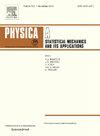Exploring network structure with the density of states
IF 3.1
3区 物理与天体物理
Q2 PHYSICS, MULTIDISCIPLINARY
Physica A: Statistical Mechanics and its Applications
Pub Date : 2025-06-09
DOI:10.1016/j.physa.2025.130742
引用次数: 0
Abstract
Community detection, as well as the identification of other structures like core periphery and disassortative patterns, is an important topic in network analysis. While most methods seek to find the best partition of the network according to some criteria, there is a body of results which suggests a single network can have many good but distinct partitions. In this paper we introduce the density of states as a tool for studying the space of all possible network partitions. We demonstrate how to use the well known Wang–Landau method to compute a network’s density of states. We show that, even using modularity to measure quality, the density of states can still rule out spurious structure in random networks and overcome resolution limits. We demonstrate how these methods can be used to find ‘building blocks’, groups of nodes which are consistently found together in detected communities. This suggests an approach to partitioning based on exploration of the network’s structure landscape rather than optimisation.
用态密度探索网络结构
社区检测,以及其他结构的识别,如核心、外围和非分类模式,是网络分析中的一个重要课题。虽然大多数方法都是根据某些标准寻找网络的最佳分区,但有大量结果表明,单个网络可以有许多良好但不同的分区。本文引入状态密度作为研究所有可能网络分区空间的工具。我们演示了如何使用众所周知的Wang-Landau方法来计算网络的状态密度。我们表明,即使使用模块化来测量质量,状态密度仍然可以排除随机网络中的虚假结构并克服分辨率限制。我们演示了如何使用这些方法来寻找“构建块”,即在检测到的社区中一致地发现在一起的节点组。这表明了一种基于对网络结构景观的探索而不是优化的划分方法。
本文章由计算机程序翻译,如有差异,请以英文原文为准。
求助全文
约1分钟内获得全文
求助全文
来源期刊
CiteScore
7.20
自引率
9.10%
发文量
852
审稿时长
6.6 months
期刊介绍:
Physica A: Statistical Mechanics and its Applications
Recognized by the European Physical Society
Physica A publishes research in the field of statistical mechanics and its applications.
Statistical mechanics sets out to explain the behaviour of macroscopic systems by studying the statistical properties of their microscopic constituents.
Applications of the techniques of statistical mechanics are widespread, and include: applications to physical systems such as solids, liquids and gases; applications to chemical and biological systems (colloids, interfaces, complex fluids, polymers and biopolymers, cell physics); and other interdisciplinary applications to for instance biological, economical and sociological systems.

 求助内容:
求助内容: 应助结果提醒方式:
应助结果提醒方式:


